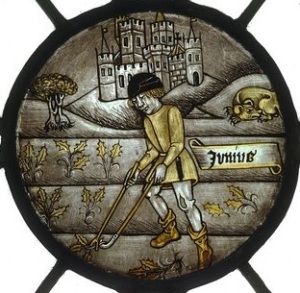Originally posted by Allison D. Reid:
In the Middle Ages, the arrival of June meant not only a change in the weather, but a shift in daily labors, and in what was on the menu to eat.
 While most crops were harvested much later in the summer, hay was the first to be cut in June, though it was typically poor quality. In a society so dependent on animals for survival, haying was a vital community activity, with the lord’s fields taking priority over all the others. This was a labor carried out by men, women, and children. They worked in groups under the supervision of a reeve that had been elected by the peasants themselves. The men cut the hay with long scythes, each going through about one acre per day. Women and girls were responsible for raking and turning it. If the hay was not able to dry out, it would rot and be of no use.
While most crops were harvested much later in the summer, hay was the first to be cut in June, though it was typically poor quality. In a society so dependent on animals for survival, haying was a vital community activity, with the lord’s fields taking priority over all the others. This was a labor carried out by men, women, and children. They worked in groups under the supervision of a reeve that had been elected by the peasants themselves. The men cut the hay with long scythes, each going through about one acre per day. Women and girls were responsible for raking and turning it. If the hay was not able to dry out, it would rot and be of no use.On the edge of the field, there would be a man with a whetstone who could make quick repairs to dull and broken scythes as needed throughout the day. A horn would be blown at dusk to signal the end of the work day. Sometimes a lord would provide the laborers with a meal and ale, or allow villagers to take home as much hay as they could carry home on their scythe. Anyone who tried to pile on too much was likely to lose their load on the way and go home with nothing.
At the end of June, it was time to pull weeds from the wheat fields, plow fallow fields, and uproot thistles. However, it was considered unlucky in England to pull thistles before June 24th (St. John’s day). Anyone who did would find they would only multiply three times over.
Bee keeping was another important activity of June, which was when they were expected to begin swarming. Watching a hive was typically children’s work, as they could do so while spinning or doing some other household task. When a swarm formed, it would be followed by villagers banging pots and making other loud noises to “help the bees settle” and also stake their claim on the swarm.
During the month of June, sheep would be taken to a pond or a stream to be washed before shearing. Running water was preferred because their wool tended to be so filthy. Other tasks for June included repairing barns and outbuildings, clearing away brush, digging hop plots, fixing broken carts, gathering hemp and flax, and making salt.
Enjoy another episode of Tales from the Green Valley, where some of the above labors and others are shown. The video demonstrates the washing and shearing of sheep, dairy production (making cheese), field labors, special foods, and June festivities. For more information about wool production, you can revisit another of my posts on the subject. Check out my Medieval Index for a variety of other topics related to the Middle Ages.


No comments:
Post a Comment